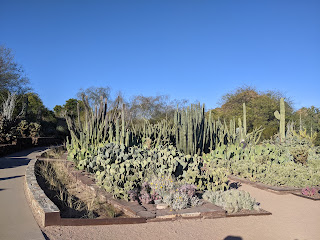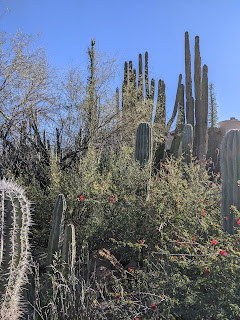As I can count on one hand the number of times we've seen vertical gardens around the world, the one at the entrance immediately caught my attention.
Fiori Boat was a blown glass and wooden boat. Chihuly first filled boats with glass in 1995 while experimenting with tossing glass forms into a river. He was so fascinated with how they looked once they had been collected, Chihuly has revisited this 'installation concept' ever since.
I'd bet a few bucks on the fact that these succulents would be in full bloom in a couple of weeks!
The large Opal and Amber Tower was created in 2018 from glass and steel. I wondered how the fragile piece was transported in one piece to its spot here in the Sonoran Desert with nothing breaking!
Salvaged Ironwood, the 20-foot tall Saguaro sculpture, was made by artist Jeff Hebets from pick heads that had been used to harvest native plants. The pice honored Hebets' cousin who originated a tree-boxing methodology that allowed over one million native plants to be salvaged instead of being bulldozed. As a result of revisions to native plant laws and the salvage process that allowed municipalities to pass ordinances that required native plants to be saved and replanted in developments, the face of landscapes in the desert Southwest has been completely changed.
The cuddly-looking Teddy Bear Cholla reminded both of us of all those we'd seen a month earlier in Joshua Tree National Park's Cholla Garden not far from Palm Springs.
Lime and Lava was also fashioned from blown glass and steel in 2021.
We learned in the Boulder Garden that some wildflowers grew best in microhabitats around boulders. That was because they were places where soil and moisture accumulated, and their north side had shady, cool areas while the south side had sunny warm areas.
I wouldn't ever want to land up in this plant - just look at its shark-tooth edges!
When we walked by the glass tree later, I just had to smile as where oh where have you ever seen a glass sculpture being cleaned?! It had to be an almost never-ending job at the Desert Botanical Garden.
As purple is one of my favorite colors, I was drawn to Neodymium Reeds.
After the Garden's first director went on an early collecting trip to Baja California, Mexico, in 1939, the 26-year-old returned with a truckload of Sonoran Desert plants. In just one very busy year, the first planting beds were set, the main building was constructed, and the Garden was opened to the public. The Heritage Garden held many original plantings from when the Garden first opened.
These Giant Mexican Cardons that towered over us were some of the original plants and were more than 75 years old. When they were first collected in Mexico, they were less than five feet tall.
I loved the name of the Boojum Tree but wouldn't have wanted to come any closer to its bark that had lots of pointy bits.
The Totem Pole Cactus reminded me of my native Canada where totem poles are common on native lands in the western part of the country.
In our travels through the American Southwest, we've seen countless saguaro cacti. Many of them look 'damaged' from gaping holes because woodpeckers peck holes to make nesting cavities inside the cactus stems. This one, however, was a 'perfect' specimen, i.e. no woodpecker holes!
Yeah, we were at the Gardens at the perfect time - just when Hamman's Prickly Cactus was blooming!
The sawtooth Aloe came from Eastern Africa.
Weber Agave:
Chihuly's Aqua Blue and Amber Chandelier was created in 2011.
People unfamiliar with deserts logically think of them as barren and hostile wastelands. However, deserts can also be lush and beautiful and are places inhabited by people for thousands of years. To survive in this part of the world, people needed to have a deep understanding of what the desert could offer them. They knew which plants to gather for food, medicine, as well as for ceremonial use. Many traditional uses of plants remain today as this knowledge of desert plants was handed down for generations.
Because the Sonoran Desert varies in soil types, landforms, and the amount of moisture, several habitats or communities of plants and animals, have developed in this area. The five habitats shown on the trail are the major ones in or near the northern Sonoran Desert.
The Garden's Desert Habitat elevation ranged from just 260 feet to 3,000 feet. We learned that towering saguaro cactus and green-trunked palo verde trees thrive in Phoenix's foothills with mesquite and ironwood trees growing in the washes thanks to runoff. In earlier times, people relied on desert habitats for shelter, medicine, and food.
With its many mountains and valleys, the desert is the largest habitat. Tall cacti, small trees, and hardy shrubs manage to survive with fewer than ten inches of rainfall a year.
The Akimel and Tohono O'odham indigenous peoples have been harvesting saguaro cacti for centuries. When families moved into saguaro forests during the summer harvests, they built ramadas like this to provide shade and ventilation while gathering saguaro fruit. The temporary shelters were furnished with beds, cooking utensils, food, and water. The roof of the shaded ramada was constructed of thick layers of arrow-weed branches supported by mesquite poles.
After the harvested fruit was cooked to a juicy pulp, the seeds and pulp were strained so the juice was cooked to make a delicious syrup. The seeds, pulp, and syrup were used in foods like porridge, jam, and seed meal.
Traditional Akimel O'odham households usually contained more than one structure, each with its own function. A roundhouse like this provided privacy, shelter, storage space, and a place to sleep.
Roofless kitchens allowed heat from cooking to escape quickly. The low walls were made of arrow-weed and the main fuel source was mesquite though palo verde and other woods were also used.
The Western Apache is one of 21 indigenous groups in the American Southwest. Traditionally, the Apache were a semi-nomadic group with a wide range of territory that included the Sonoran Desert. Their nomadic lifestyle allowed them to move seasonally through a variety of habitats which provided the materials required for shelter, food, medicine, and basket making.
This Mesquite Corral was typical of those built by Spanish ranchers to contain their livestock. Though it's much easier to build a livestock fence of wire, small mesquite corrals are still found in some areas because of their low cost and durability. After the Spanish introduced livestock, life in the desert changed a great deal. Animals made traditional activities like hauling heavy loads, growing crops, traveling, and trading easier. Caring for livestock, though, added new responsibilities to people's daily routines.
Nearby was the Desert Oasis where, unsurprisingly, water is scarce but still found in streams and occasional seeps and springs. That was why Cottonwood, willow, and other trees not normally found in the desert can grow beside these sources of water. Materials for construction are also found in desert oases from bent willow saplings and poles from other trees making strong supports.
Adjacent to the oasis was the Semidesert Grassland where the elevation ranged from 3,600 feet to 5,600 feet and it receives from 10-18 inches of rain each year. People from the desert often traveled to nearby desert grasslands to grow plants and hunt animals on a seasonal basis. Many types of grass have edible seeds that were collected by shaking trees into baskets.
The dense Chaparral Forest looked so unlike the other areas we'd just walked through!
This Cauliflower Saguaro just had to be one of the strangest cacti we've ever seen! Here are pictures of the Garden's only one from front and back.
Imagine cleaning the marvelous Red Reeds blown glass sculpture!
The Garden had a huge number of Organ Pipe cacti.
The barrel cactus does contain water but I read that it's not free-flowing. Instead, it's stored in special water-storing tissues, a little like a juicy potato. Small animals like jackrabbits rely on cacti as water sources during the driest periods of the year. People in the past also used the moist pulp of the barrel cactus as an emergency source of moisture. That's not recommended, though, because some species can be toxic to humans. Even if that weren't the case, the Arizona Native Plant Law precludes people from collecting or destroying barrel cactus and other desert plants.
At the Garden's highest spot we had some great views of the mountains that rimmed Phoenix. One was of the city's most familiar landmarks, 2,700-foot-high Camelback Mountain, four miles away from this part of the Desert Botanical Garden.
Looking another direction, seven miles away was 2,608-feet-high Piestewa Peak where we'd hiked one of the trails several days previously. The peak is part of the City of Phoenix Mountain Preserves, one of the largest preserve systems of any city in the country.
Six miles away was one of the Papago Buttes which we hoped to hike before leaving Phoenix. The 140-acre Garden itself was in Papago Park as was the Phoenix Zoo.
I didn't see the sign indicating the name of this Chihuly piece, IF I were naming it, I'd be tempted to call it Bad Hair Day!
Before leaving the Garden, we made sure to see more of Chihuly's works in an indoor space dedicated to the celebrated American glass artist. After graduating in 1965 from the University of Washington where he'd been introduced to glass, Chihuly enrolled at the University of Wisconsin in the first glass program in the US. He later worked at the Venini glass factory in Venice where he observed the team process of blowing glass, a technique the artist still uses. His work is included in more than 200 museum collections worldwide! We've been lucky enough to see more than a smattering of them.
The combination of coming across Chihuly's stunning glass sculptures as we strolled through the various habitats and the almost endless varieties of succulents made for a not-to-missed visit to Phoenix's Desert Botanical Garden set amid a lovely backdrop.
Posted on March 12th, 2022, from Chicago, Illinois this time as I flew out for a long weekend to see our 20-month-old granddaughter for the first time since August. Covid has sure put a helluva monkey wrench into so many people's plans to connect with loved ones living far away. With the pandemic easing up now, I hope we, like so many others the world over, will be able to see more of those who have been separated due to the awful scourge.






































































We MUST visit the botanical gardens when we return to AZ.. thanks so much for the tour , through your discerning lens.. loved it.
ReplyDeleteThey're fantastic and worth a visit every year in our opinion. The Chihuly glass pieces were the cherry on the top!
Delete